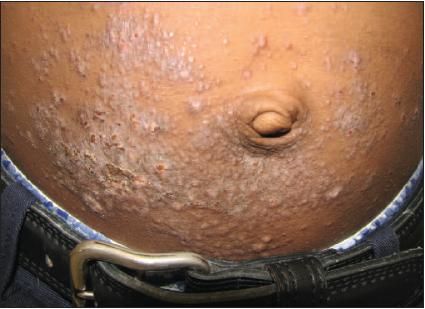Nickel Dermatitis
For the past few weeks, a 10-year-old boy had a pruritic abdominal rash that had not responded to over-the-counter topical medications. The rash had appeared around the time he started wearing a new belt (shown). The child was otherwise healthy. There was a family history of asthma.

For the past few weeks, a 10-year-old boy had a pruritic abdominal rash that had not responded to over-the-counter topical medications. The rash had appeared around the time he started wearing a new belt (shown). The child was otherwise healthy. There was a family history of asthma.
Allergic contact dermatitis from the nickel in the child's belt buckle and the buttons on his pants was diagnosed. Nickel is the most common cause of metal sensitivity.1 The average prevalence of nickel allergy is almost 9% in the general population.2 Skin contact with nickel results when sweat or friction causes the metal to leach out of buttons, zippers, belt buckles, and jewelry. Patch testing is generally not needed to confirm the diagnosis.
The only definitive treatment is avoidance of the allergen, in this case, the belt buckle and buttons. Placing tape or clear nail polish on small metallic objects, such as buttons, can prevent contact. Inexpensive home kits are available to test metallic objects for nickel content. Use of cool compresses and antihistaminies can relieve associated symptoms. Potent topical corticosteroids are also effective for treating small areas of moderate contact dermatitis. Topical immunomodulators have been used as second-line therapy. Oral corticosteroids are usually indicated when more than 10% of the body surface area is involved.3
This patient was treated with topical triamcinolone and oral diphenhydramine. The rash resolved about 2 weeks after he discontinued wearing the belt.
References:
REFERENCES:
1.
Hurwitz S.
Clinical Pediatric Dermatology: A Textbook of Skin Disorders of Childhood and Adolescence.
2nd ed. Philadelphia: WB Saunders; 1993:68-77.
2.
Thyssen JP, Linneberg A, Menné T, Johansen JD. The epidemiology of contact allergy in the general population-prevalence and main findings.
Contact Dermatitis.
2007;57:287-299.
3.
Bruckner AL, Weston WL. Allergic contact dermatitis in children: a practical approach to management.
Skin Therapy Lett.
2002;7:3-5.
Recognize & Refer: Hemangiomas in pediatrics
July 17th 2019Contemporary Pediatrics sits down exclusively with Sheila Fallon Friedlander, MD, a professor dermatology and pediatrics, to discuss the one key condition for which she believes community pediatricians should be especially aware-hemangiomas.